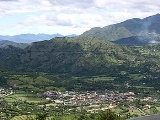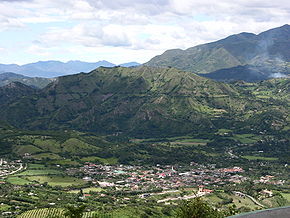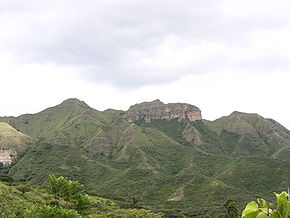
Vilcabamba, Ecuador
Encyclopedia


Ecuador
Ecuador , officially the Republic of Ecuador is a representative democratic republic in South America, bordered by Colombia on the north, Peru on the east and south, and by the Pacific Ocean to the west. It is one of only two countries in South America, along with Chile, that do not have a border...
, in the Loja province
Loja Province
Loja Province is one of 24 provinces in Ecuador and shares its southern border on the west by El Oro Province, on the north by El Azuay, and on the east by Zamora-Chinchipe. Founded on its present site in 1548 by Captain Alonso de Mercadillo the site had been previously moved and rebuilt from La...
, about 45 km (28 mi) from the city of Loja
Loja, Ecuador
Loja is the capital of Ecuador's Loja Province. It is located in the Cuxibamba valley in the south of the country, sharing borders with the provinces of Zamora-Chinchipe and El Oro, and with Peru in the south...
. The etymology of the “Vilcabamba” apparently derives from the Quichua “huilco pamba.” Huilco
Vilca
Anadenanthera colubrina is a South American tree closely related to Yopo, or Anadenanthera peregrina. It grows from 5 m to 20 m tall and the trunk is very thorny. The leaves are mimosa-like, up to 30 cm in length and they fold up at night. In Chile, A...
denotes the sacred trees, Anadenanthera colubrina, that inhabit the region and pamba is a word meaning “a plain.” (cognate with pampa
Pampa
The Pampas are the fertile South American lowlands, covering more than , that include the Argentine provinces of Buenos Aires, La Pampa, Santa Fe, Entre Ríos and Córdoba, most of Uruguay, and the southernmost Brazilian State, Rio Grande do Sul...
) The area has been referred to as the "Playground of the Inca" which refers to its historic use as a retreat for Incan
Inca Empire
The Inca Empire, or Inka Empire , was the largest empire in pre-Columbian America. The administrative, political and military center of the empire was located in Cusco in modern-day Peru. The Inca civilization arose from the highlands of Peru sometime in the early 13th century...
royalty. The valley is overlooked by a mountain called Mandango, the Sleeping Inca, whose presence is said to protect the area from earthquakes and other natural disasters.
Reputation for longevity
Located in a historical and scenic valley, it is a common destination for tourists, in part because it is widely believed that its inhabitants grow to a very old age. Locals assert that it is not uncommon to see a person reach 100 years of age and it is claimed that many have gotten to 120, even up to 135, which would make it an area with the oldest inhabitants in the world. It is often called the Valley of Longevity.The reasons for this claimed longevity
Longevity
The word "longevity" is sometimes used as a synonym for "life expectancy" in demography or known as "long life", especially when it concerns someone or something lasting longer than expected ....
are not very clear. French studies have shown that the diet and lifestyle of the inhabitants may be a factor. Dr. Richard Laurence Millington Synge, a Nobel Chemistry Prize
Nobel Prize in Chemistry
The Nobel Prize in Chemistry is awarded annually by the Royal Swedish Academy of Sciences to scientists in the various fields of chemistry. It is one of the five Nobel Prizes established by the will of Alfred Nobel in 1895, awarded for outstanding contributions in chemistry, physics, literature,...
winner and the man who discovered amino acids, claims that there are remarkable medicinal qualities to be found in the plant-life in certain places near the Equator .... with the valley of Vilcabamba being one of these areas. Due to scientific chemical assay techniques, analysis has now shown that the fruit, roots and herbs of this particular Equatorial sub-area offer some of the strongest anti-oxidant protection in the world. In 1973, Dr. Alexander Leaf of Harvard Medical School
Harvard Medical School
Harvard Medical School is the graduate medical school of Harvard University. It is located in the Longwood Medical Area of the Mission Hill neighborhood of Boston, Massachusetts....
introduced these remarkable people to the world for the first time in his cover story for National Geographic Magazine.
In 1981, the Ecuadorian government hired medical journalist Dr. Morton Walker to study these people in depth. In his book, "The Secret to a Youthful Long Life", Dr. Walker reported that his research showed the mineral rich water that the Vilcabambans drank was key to their long lives and health. Laboratory analysis of the Vilcabamba water determined that the unique balance of enriched colloidal minerals in the local drinking water was ideal for promoting optimum human health.
Medical researchers have confirmed that the retinas of 100 year-old residents are often comparable with those of 45 year-old city-dwellers. Others suggest that the climate in the region, which is reasonably steady without much variation, or the mineral
Mineral
A mineral is a naturally occurring solid chemical substance formed through biogeochemical processes, having characteristic chemical composition, highly ordered atomic structure, and specific physical properties. By comparison, a rock is an aggregate of minerals and/or mineraloids and does not...
content of its drinking water is particularly healthful and explains the advanced age of its inhabitants.
Skepticism concerning longevity claims
According to The Bewildering History of the History of Longevity by Peter LaslettPeter Laslett
-Biography:Born Thomas Peter Ruffell Laslett and educated at the Watford Grammar School for Boys, Peter Laslett studied history at St John's College, Cambridge in 1935 and graduated with a double first in 1938. During the war he learned Japanese and worked at Bletchley Park and Washington decoding...
, "geographical variation in the incidence of long life is no doubt a reality but better general survival does not demonstrably raise the probability of extreme ages and systematic, sceptical analysis of these confidently asserted propositions has condemned them as entirely baseless."
Longevity in Vilcabamba has been attributed to nothing more special than the benefits of exercise, a healthy diet and good treatment of the elderly by the community. Longevity of the residents has also been attributed to a result of migration of younger people to cities.

